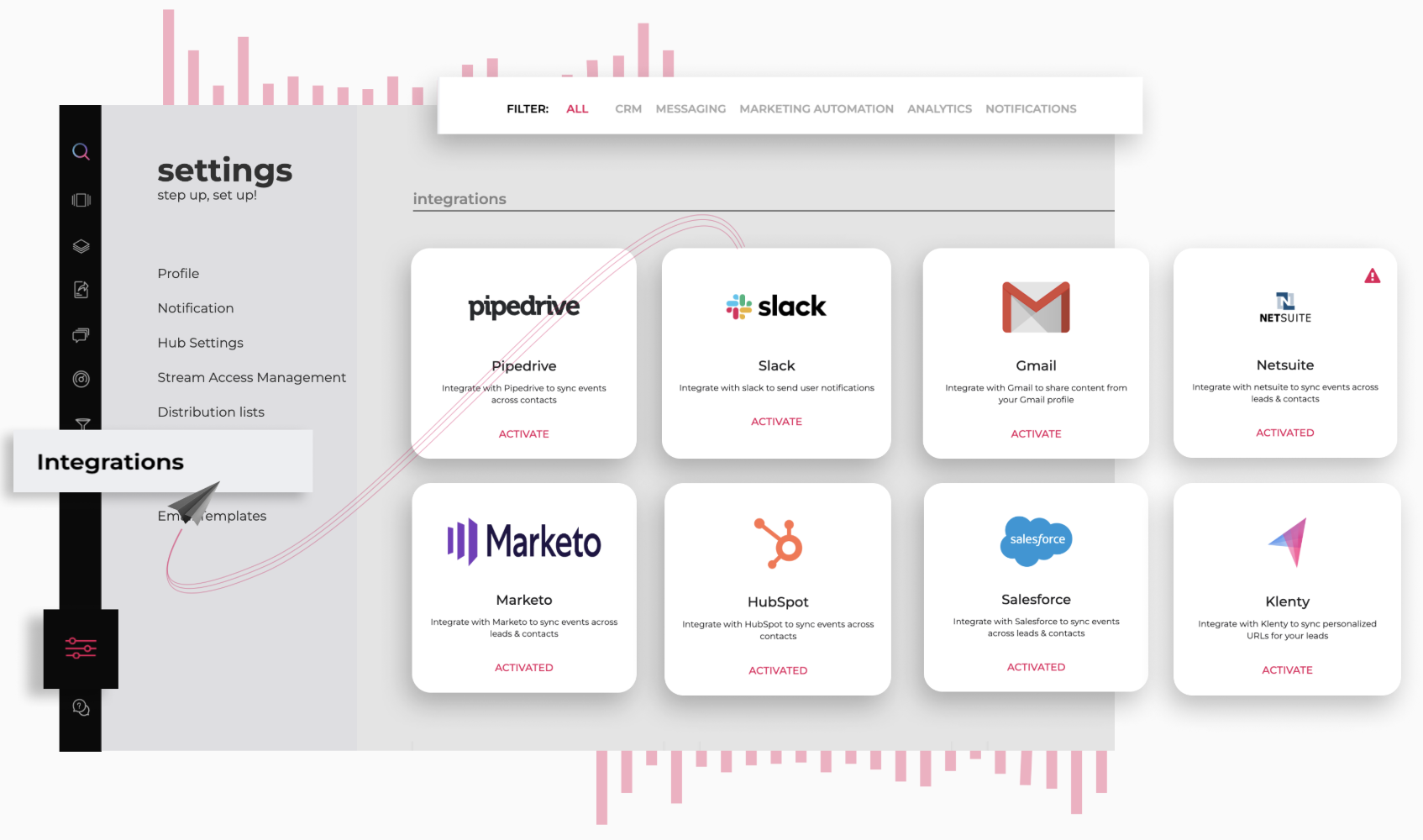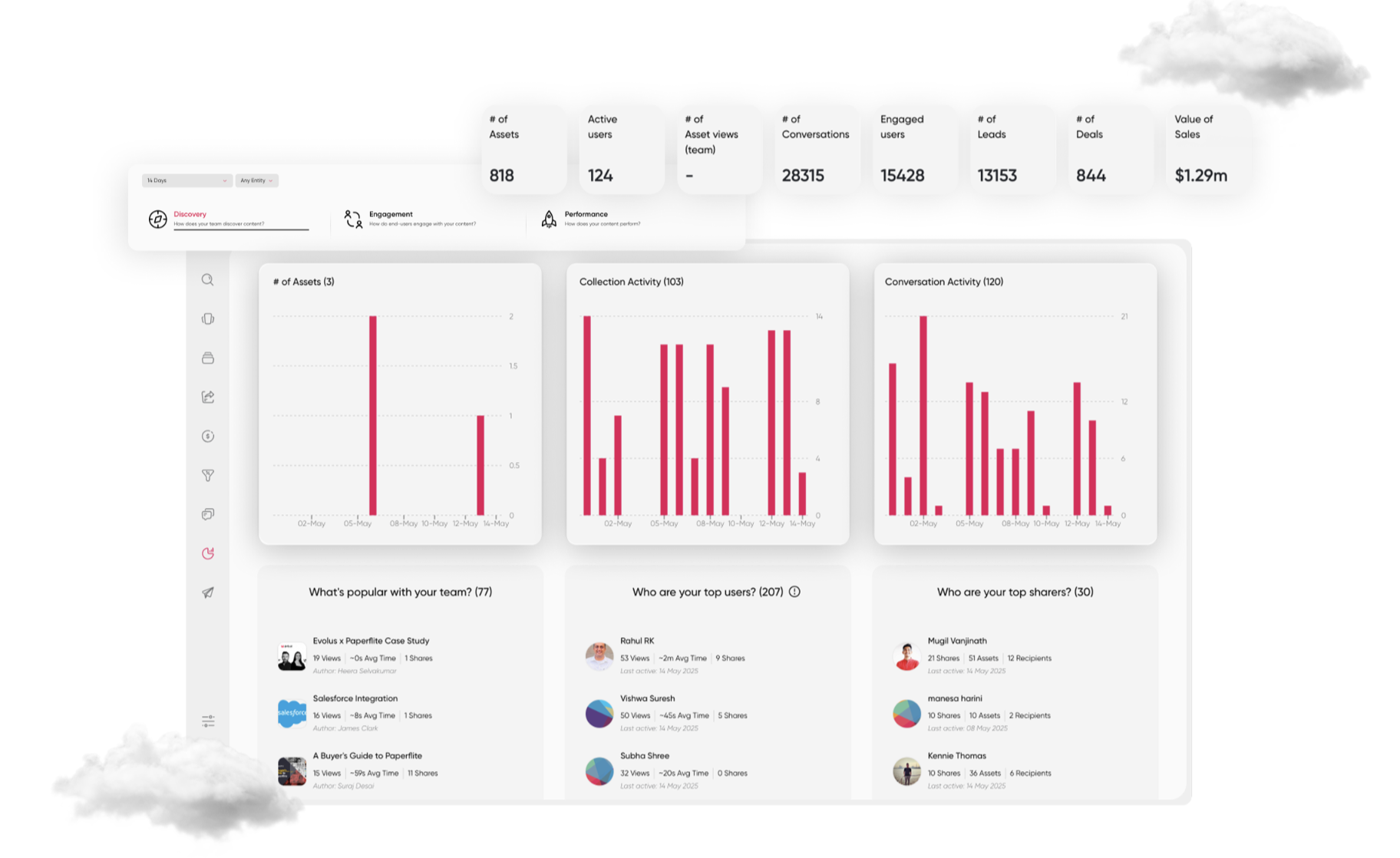How to do Enterprise Content Management- centric integration?
Enterprise Content Management (ECM) systems were introduced with the promise of solving the chaos around enterprise content making it organized, accessible, and secure.
But here’s the reality check: most organizations that invest in an ECM platform still struggle with content sprawl, disconnected workflows, and underutilized assets.
Why? Because they stop at adoption, not integration.
Without integration, Enterprise Content Management system becomes static repositories content is stored but not surfaced where it's needed. Reps can’t access materials in their CRM, marketers lack performance insights, and compliance workflows remain manual and fragmented.
The result: siloed content that doesn’t move the business forward. True ROI starts when your ECM is wired into your broader tool stack enabling content to be discovered, delivered, and tracked in real time.
In this blog, we’ll break down which tools to integrate, why they matter, and how solutions like Paperflite make ECM a true engine for execution.
What Tools Should Integrate with an ECM System and Why?
If your ECM exists in a vacuum, it’s just a glorified content vault. The real power of enterprise content management is unlocked when it becomes interoperable deeply connected to the tools your teams already live in.
Here's a breakdown of the key categories of tools that must be integrated, why each matters, and how Paperflite brings that integration to life.
CRM Systems (e.g., Salesforce, HubSpot)
Why integrate:
Sales reps operate inside CRMs. If content isn’t available in the same environment, they won’t use it.
Integrating your ECM with CRMs ensures that sales collateral, pitch decks, case studies, and pricing sheets surface contextually based on opportunity stage, buyer persona, or past interactions.
Impact:
-
Personalized content delivery within deals
-
Triggered content suggestions based on CRM fields or deal stage
- Seamless engagement tracking directly tied to sales outcomes
Paperflite advantage :

Paperflite’s Salesforce plugin embeds content discovery, sharing, and engagement analytics inside the CRM.
It not only lets reps send content from within their opportunity view but also shows how recipients engage helping teams follow up with precision.
Cloud Storage Tools (GDrive, Dropbox, Box, SharePoint)
Why integrate:
In most enterprises, content lives everywhere.
Without syncing your cloud drives into your ECM, teams spend more time searching than selling or creating.
Integration reduces duplication, syncs updates automatically, and enforces version control.
Impact:
- Centralized visibility without physically relocating files
- Reduced content chaos across teams and departments
- Improved governance with unified file tracking
Paperflite advantage:

Paperflite syncs with GDrive, SharePoint, Dropbox, and Box to unify assets in one Content Hub organized by streams without disrupting original ownership.
With Seek, users can instantly find exact content (even inside documents) through contextual, keyword-driven search cutting down discovery time and boosting usability.
Communication & Productivity Tools (Outlook, Gmail, Slack)
Why integrate:
Content sharing often starts in conversations.
If your ECM doesn’t integrate with email or collaboration tools, reps and marketers default to attachments and manual copy-paste chaos.
Embedding content into communication tools makes the sharing frictionless and trackable.
Impact:
- Faster response times with in-context content suggestions
- Elimination of non-trackable, outdated content sharing
- Increased adoption by embedding ECM into daily habits
Paperflite advantage:
With Paperflite’s Outlook and Gmail integrations, reps can share collections and assets without leaving their inbox.
Using “Compose,” users create visually rich, trackable content experiences directly inside their email composer.
Slack integrations and shareable campaign links extend the same agility to internal workflows and team updates.
Marketing Automation & Campaign Tools (Marketo, HubSpot)
Why integrate:
Marketers need visibility beyond opens and clicks they need to know what content drives conversion.
ECMs that plug into campaign tools close the loop between content creation and lead impact.
Impact:
- Funnel-wide attribution for each asset
- Smarter content strategy based on lead engagement
- Lead scoring and routing based on content interactions
Paperflite advantage:
Paperflite supports UTM tagging, email gating, and campaign-based sharing, enabling granular attribution.
Every content touchpoint can be tied back to lead performance, helping marketers fine-tune their messaging and sales enablement collateral.
Enablement & Learning Systems (LMS, LXP)
Why integrate:
Enablement teams craft onboarding journeys, but often don’t see how reps use content in real scenarios.
Tying ECM into learning platforms lets you surface real-time content usage, simulate buyer conversations, and adapt training based on in-market behavior.
Impact:
- More contextual learning paths
- Shorter ramp-up time for new hires
- Alignment between learning content and live selling content
Paperflite potential:
While not a full LXP, Paperflite’s content analytics and personalized collections support adaptive onboarding strategies.
Analytics & BI Tools (Tableau, Power BI)
Why integrate:
Content performance shouldn’t be a black box.
Executives need ECM data views, downloads, time spent, re-shares rolled into broader BI dashboards to inform investment and governance decisions.
Impact:
- Executive visibility into what content drives revenue
- Better forecasting and pipeline strategy
- Governance dashboards for audit and compliance
Paperflite advantage:

While full BI integrations may still require connectors,
Paperflite’s built-in analytics Reports, Conversation Intelligence, and the Deal Room dashboard offer role-specific visibility.
CIOs can track usage by department; marketers can measure campaign ROI; sales leaders can see engagement by account.
Paperflite in Action: Integration Blueprint for Scalable ECM
A connected ECM system is only as strong as its ability to sync with your everyday tools without demanding workflow changes.
This is where Paperflite stands apart, enabling deep, seamless integrations that don’t just “connect” but activate content across systems.
Here’s what that looks like in action:
Integration Stack: Plug-and-Play with Your Core Tools
Paperflite’s integration ecosystem supports a wide array of enterprise tools Salesforce, Gmail, Outlook, SharePoint, Dropbox, Box, and Google Drive. Rather than simply linking,
Paperflite ingests and organizes content from these sources into a unified Content Hub, while preserving native file ownership and structure.
Admins can manage integrations easily through Paperflite’s settings dashboard assigning access rules, scheduling syncs, and enforcing security protocols.
(You could show the visual from the onboarding guide where integration toggles are displayed alongside platforms like Gmail, Salesforce, and SharePoint.)
This means your teams don’t need to migrate content—they just sync, search, and share from one central place.
Use Case: Deal Room Meets CRM & Outlook in Real Time
Let’s look at how this works in a live sales scenario: A rep identifies an opportunity in Salesforce.
With the Paperflite plugin, they quickly pull in a relevant collection case studies, pricing sheets, testimonials and send it directly from Outlook using Paperflite’s “Compose” feature.
The prospect opens the content.
That interaction is immediately tracked time spent on each asset, re-shares, and drop-off points. This data flows into Paperflite’s Conversation Intelligence module, where the rep sees exactly what caught the buyer’s attention.
Here’s the best part: within that same interface, the rep can initiate a live chat using Engage. They’re not just following up they’re following through in the moment, with full context.
This exact workflow mirrors the approach taken by Perfection Learning, as shared in their case study.
By integrating Paperflite with their sales stack, they streamlined deal cycles and improved rep engagement by tying content delivery directly to buyer intent signals.
Future-Proofing ECM Integrations
Integration isn’t a one-time event it’s a foundational capability that must evolve with your business.
As digital ecosystems grow more complex, future-proofing your ECM integrations ensures that your content strategy doesn’t fall behind.
Here are three principles to guide that strategy:
Scalability:
Your ECM shouldn’t break the moment your organization expands into new markets or departments.
Future-ready integrations must scale across geographies, business units, and permission layers without manual overhead.
With Paperflite, teams can segment content streams by region, department, or use case ensuring localized control and global access.
Admins can define visibility rules, language-specific collections, and role-specific dashboards to maintain governance at scale.
Interoperability:
Avoid closed systems.
The best integrations are powered by open APIs and flexible data models, allowing your ECM to adapt as new tools enter your stack.
Whether you're adding a new marketing automation platform or shifting to a different CRM, your ECM should plug in not stall.
Paperflite supports API-based connections and dynamic content ingestion from third-party sources, making it adaptable to your evolving tech environment.
Security:
As content becomes more accessible, security must tighten.
Every integration should be backed by strong access controls, share-level visibility settings, and engagement safeguards.
Paperflite ensures this with role-based access, OTP-secured content sharing, link expiry settings, and permissions that control download, re-share, or viewability giving IT teams peace of mind without compromising user agility.
Future-proofing isn’t just about adding more tools it’s about building an integration layer that is flexible, secure, and extensible by design.
Conclusion: Your ECM Is Only As Powerful As What It Connects To
Content doesn’t operate in isolation neither should your ECM. An ECM that stores content but doesn’t integrate with your sales, marketing, communication, or analytics tools is underperforming by design.
Integration isn’t a feature—it’s the engine that turns passive content into active business outcomes.
As we’ve seen, connecting your ECM to the right tools transforms it into a real-time, insight-rich system that supports sales execution, marketing performance, onboarding, and enterprise-wide compliance.
So here’s your next step:
Evaluate your integration maturity.
Is your ECM just a place to put content—or is it the backbone of how content flows through your organization?
If it’s the latter, it’s time to optimize. And if you’re using Paperflite, much of that foundation is already built in—ready to be activated.
